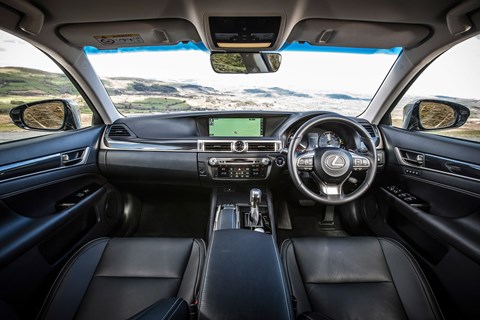► New E-class takes on its established rivals
► Faces off against Jag’s XF and Lexus GS
► Can the newcomer usurp exec wannabes?
Judging by the way the seat belt keeps snapping at my shoulder, like a nervous passenger flailing away in the back seat, the new Mercedes E-class doesn’t approve of my driving. The sudden tightening of the restraint is an early warning symptom of the E220d’s ‘pre-crash’ safety systems, designed to lock the occupants back against the protective shell of the seat in case of evasive manoeuvre or impact.
I strongly suspect the Mercedes is casting aspersions on my roundabout approach velocity, as the belt slapping occurs in the vicinity of several such pieces of road furniture in a row, but such are the number of Pre-Safe™ technologies bundled within the optional Driving Assistance Plus Package that it could just as easily be fretting about the proximity of rival – sorry – other vehicles both to the side and behind me. Whatever the cause, with this and all the other technical assistance it’s more than eager to render, you sense the new E-class is of the opinion it’s better at this driving thing than you are. A position I’m inclined to dispute.
New 2016 Mercedes-Benz E-class: a techfest
We’ll get on to that in a moment. As a starting point it’s enough to understand that the new E is setting out its stall as a technological tour de force. If you accept the old adage that claims even the simplest in-car ECU has more computing power than the Apollo Guidance Computer that put Neil Armstrong and Buzz Aldrin on the Moon, then the 2016 E-class must be gearing up to take on the Galactic Empire single-handed; here’s hoping it does less hand-wringing than C-3PO and proves more intelligible than R2-D2 in the process.
Either way, don’t think you get all the toys as standard – even in top level AMG Line specification, as tested here, you have to pay extra not just for the aforementioned full-fat driver assistance but also ‘proper’ sat-nav (rather than the pokey Garmin set-up) and the twin 12.3-inch digital displays that take the interior into beam-me-up territory. All of which and more sees this modest 192bhp 2.0-litre diesel – the only engine on offer at UK launch – rise with apparent equability from £38,430 to £51,130.
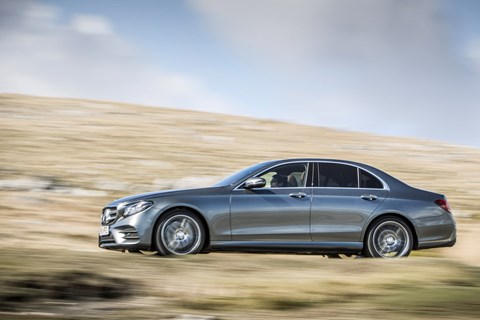
For better or worse, one of the rivals we’ve brought along to test the Mercedes’ credentials is prepared to meet this monetary challenge. No doubt the second-gen Jaguar XF looks the business in 178bhp R-Sport guise, but surely I’m not alone in raising an eyebrow at its own meteoric ascension from £36,850 basic to £49,500 as tested. It too turns its rear wheels with a 2.0-litre turbodiesel, for context. For contrast, we’ve also brought along a Lexus GS300h, which in common with the brand’s staunchly anti-derv policy, does not. Instead there’s a 2.5-litre petrol four and an electric motor sending a combined system power of 220bhp to the rear axle; somewhat disappointingly, this entry-level Executive Edition example carries a sole option – the Sonic Titanium metallic paint – and thus only works out £610 more than its £33,495 list. For shame. Why no BMW 5-series or Audi A6? Because they’re old, and due for replacement within months; the Jaguar was all-new last year and drives superbly, the GS has just been updated and recent winning form suggests Lexus should have its also-ran status officially revoked any day now.
You approach the E-class with a mix of familiarity and admiration: it does look like a super-size C-class now, but it’s no less handsome for that, and the AMG Line body kit adds a suitable amount of muscle tone, emphasising its presence. Frankly though, it could look like a box of cornflakes on the outside and people would still want to get in, because the interior is on a higher plane than anything we’ve ever seen before in this sector. It’ll cost you to make it look this good – that’s £1595’s worth of Saddle Brown Nappa leather, £2k combined for the Comand online infotainment upgrade and digi-screen for the dials, nearly £4k for the Premium Plus Package that includes the dual glass roof setup and 13-speaker Burmester surround sound hi-fi – but the quality is outstanding and the overall impression is one not so much of a car as a really, really nice private jet.
Inside the Merc E-class cabin
From the subtle backlighting on the door-mounted seat adjustment controls and the mind-boggling choice of 64 colours for ambient illumination to those dual 12.3-inch screens, sitting so sublimely behind a single sweeping vista of glass, the E-class feels every inch the 50 grand car. In this spec the cabin has a sense of space and refined luxury that exposes the S-class for the ancient relic it is at a whole three years old now – and that’s before you get to the new touch-sensitive thumb controls on the steering wheel. One of four methods (by my count) of controlling the infotainment system, these are a little fiddly at first but give you full access to almost every on-board function while literally allowing you to keep your hands on the wheel at all times. Which is a little ironic, given the E-class is also fully capable of steering itself for usefully lengthy periods of motorway time.
Probably, some will find the baroque majesty of the Mercedes’ cockpit overwrought and gauche – and indeed, there are moments when you wish the displays would spend less time animating the process and just get on with carrying out your demands. Being able to customise the dial pack, replacing the rev counter graphic with everything from a secondary map display to a consumption meter for example, is fun for a time, yet you wonder how often actual owners will bother once the first five minutes of fascination has passed. But the fundamental usability of what Mercedes has brought to bear here is exceedingly impressive and, once you get used to having a gear selector where every other car manufacture puts the windscreen wiper stalk (seriously, Mercedes? Do you really want people putting the car into neutral at speed?) the ergonomics are excellent – including the comfiest front seats on test. In the rear, knee room isn’t quite as generous as it is in the Jag, but will still accommodate six-footers with limited complaint. 4

Basically, whether you’re picking up a business associate or a close personal companion, the E-class is going to make them go coo. In the XF you’ll be lucky if they give anything a second glance – not least because some of the plastics look and feel like they’ve been recycled from Playmobil (and sadly it’s often on the bits you touch the most). Okay, so general quality is essentially fine and there’s visual theatre in the revolving air vents and the suggestive rising of the gear selector, but with its otherwise plain interior design, tiny touchscreen and limited evidence of even the bluntest cutting edge you find yourself wondering where all the options spend has gone.
To be fair, it does have autonomous braking and cruise control that can react to changes in the speed limit, but ‘Pedestrian Contact Sensing’ suggests it’ll let you know when you hit someone (really it’s the name for the bonce-cossetting pyrotechnic bonnet), and £1220 for a diddy head-up display that looks barely up to what the Germans were using two generations ago seems a joke. Plus the seats are hard, and the Playmobil plastic paddleshifters actually rattle.
The Lexus GS interior
Lexus buyers might have a moan or two about the hyperactive sensitivity of the Remote Touch infotainment interface until they acclimatise, and be justifiably bitter about the ridiculous lack of full postcode entry in the sat-nav, but otherwise they’re going to be laughing – at Jaguar buyers’ expense. While the dials are analogue (like the RX, they rely on clever variable illumination to change function with driving mode) the Mercedes-matching 12.3-inch widescreen central display comes as standard; this doubles as a DVD player when parked, while even the basic hi-fi has 12 speakers and sounds tremendous.
As with the plain Jane, non-F-Sport exterior, the muted colour pallet inside this example masks the material quality somewhat, but the GS is beautifully built with a surprising playfulness to the details. I’d forgive anyone who bought one just for the unnecessarily indulgent animation to the individual climate control temperature displays. It’s a lovely place to spend time, belying any intimation that Japanese cars lack soul.
As you’d expect from a petrol-electric combination, the GS is also refined on the move – by far the most tranquil of this trio, at least until you need to flatten your foot for an overtake and the Achilles’ heel that is its constantly variable transmission rears its head. Although Lexus has successfully muted the volume compared to earlier iterations, it’s decidedly less easy to ignore the mooing when there’s a mere straining four-pot attached, rather than a more deeply endowed and sonorous six-cylinder. And besides, the trouble isn’t just the noise, it’s the response; despite 221lb ft of assistance from the e-motor, the 300h feels blunted, and is swiftly ditched by the other pair with their diesel turbos and conventional auto combinations whenever their drivers are of a mind.
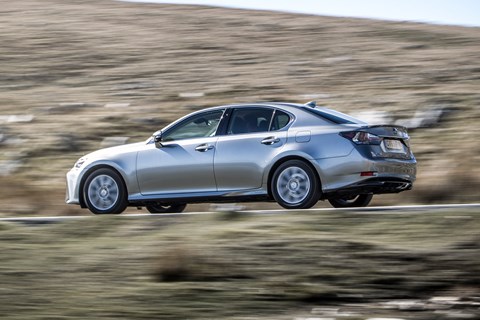
A bigger surprise is that the Jaguar is more refined than the wunderkind Mercedes. It’s not that the E220d’s all-new 2.0-litre diesel isn’t smooth – it really is, very, and compared to the gnarly old 2.2-litre unit it’s practically librarian-approved when it comes to the vocals – but there’s an unexpected degree of constant road noise in the E-class, and a strange hollowness to the sound of thumps and bumps as they’re transmitted through the chassis, that threatens to undermine the high premium ambience that interior has done so much to instil. The Jaguar is far better isolated from the surface beneath you and engine noise from the almost-as-new Ingenium 2.0-litre is well repressed, leaving only the faint whisperings of wind noise round the door seals to irritate passengers.
The sense that all is not quite as luscious as it could be in the E-class’s undercarriage extends into the other areas of the driving experience. And I wonder if it’s due to the £1495 air suspension. There are some substantial pluses to this system – the difference between Comfort and Sport+ is atypically and pleasingly broad while maintaining decent body control in the former and a useful degree of compliance for the latter – but as with many air-sprung systems it never entirely settles down on the motorway, fidgeting away in a niggling fashion. It also has an almost alarming aversion to surface corruption when laterally loaded; hit a depression mid-corner and in Comfort it skips and jiggles to the extent the first time it happened I thought something had broken. But it’s quickly apparent this is just a characteristic of the car, exacerbated by the zero-feel steering.
The Lexus is unexpectedly crisp at the helm, reinforcing the firm’s stated commitment to improving this area. But the suspension struggles to fully deal with the car’s 1730kg mass – it leans the most, lets go the earliest and yet still comes across as overly firm and pattery on the motorway, in spite of 17-inch alloys that are two inches smaller than the others’. Yet it’s the slurring imprecision of the CVT that really hampers its progress cross country; though this improves if you switch to Sport and use the paddles to enforce artificially concocted gear ratios, bringing a more natural rhythm to give-and-take driving, the GS300h is unlikely to be a car you’ll ever take out for fun. Lexus is unlikely to hold this against you – the highchair-style seating position and general aura of calm speak more of hushed ease than hooliganism.
Jaguar XF: the hooligan’s choice
If you do want to be a hooligan, buy the XF. This car 4 absolutely loves a corner. In fact, the front end is so positive at times you could almost be driving a hot hatch, tucking into apexes with hungry enthusiasm. It’s also keenest here to involve its rear end – not in a lairy way, rather in terms of the drive it delivers out of the corner, propelled by the most urgent engine. The E220d wins on headline power but the XF has more torque, leaving the Mercedes feeling decidedly lethargic next to the Jaguar’s eager immediacy. Perhaps it’s the accelerator pedal mapping; certainly the Jaguar’s eight-speed auto has aggressively abrupt upshift programming when using the paddleshifters in its Dynamic driving setting, practically banging home the changes – which might explain the hot oil smell after stints of hard charging. Given this conviction you’d understand if the R Sport was bumpy and jarring in pursuit of precision polishing body control; instead it is just beautifully damped, flowing over surface intrusions, rolling just enough to let you know it’s trying, helping you understand how full-on you can go.
At 1680kg the E-class is some 85kg heavier than the XF (and just 50kg shy of the Lexus, despite that car’s batteries and electric motor), an instant handicap to tarmac gymnastics. Even so, the lack of bite from this all-new engine remains a constant disappointment – goodness the forthcoming E200d variant is going to feel slow. Yet the nine-speed auto is a triumph of buttery anticipation, and the Mercedes continues to prove full of surprises when pointed along Welsh hillside passes in anger. Dial up Sport+ and it’s like this fat C-class sucks in its stomach and tenses its core, spearing through tricky switchbacks and shrugging off crests and camber changes like a much smaller machine.
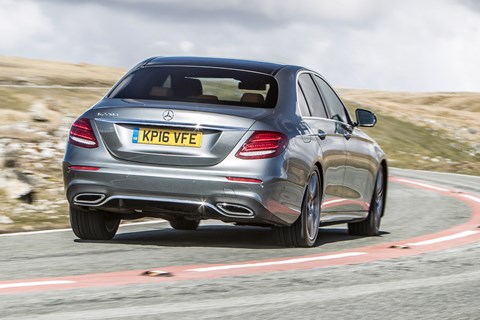
It isn’t as nimble or immediate as the XF, but it leans less and inspires your engagement, and the way the gearbox predicts the correct downshift points when left to its own devices is genuinely uncanny. I wouldn’t say the same about the piloted driving gizmos, however; the self-steering system tends to ping-pong between lane edges like a drunk unless the weather’s perfect and there’s a car ahead for it to follow, and on one occasion the cruise control took it upon itself to accelerate up to an apparently imagined higher limit when I’d specifically set it to match an average-speed-camera mandated restriction. Not cool.
I like each of these cars, and it’s not difficult to understand their choice of priorities. The Lexus is a serene cocoon of unassuming luxury; it won’t suit a sharp driver but it’ll steal you away from the monotony of your commute with its refinement and delightful depth of quality. The Jaguar is the opposite – it feeds the driver’s appetite with its brilliantly judged chassis, but feels a generation behind on the inside. While some may well prefer this less ostentatious approach, the sheer fabulousness of the Mercedes is impossible to overlook, and you can of course make it more demur than this example with different trim choices.
The debate over piloted driving – and this is just the tip of the iceberg – will rage on, but otherwise the E-class’s tech integration is amazingly intuitive, and as a total package this car has astonishingly wide breadth, able to delight both driver and passengers alike. There are chinks in its armour, though, which surely both BMW and Audi will be looking to exploit when their all-new executive warriors appear over the horizon.
Verdict
1st: Mercedes-Benz E220d AMG Line
The genius is that they’ve understood this isn’t a petrolhead market, and served up a classy, smart, desirable bit of kit
2nd: Jaguar XF 2.0d 180 R Sport
If we spent all our time nailing B-roads on sunny days the Jag wins. But we don’t and, in this edgy company, it doesn’t
3rd: Lexus GS300h Executive Edition
A good car, but neither the best to drive nor the most impressive to spend time in. When did this sector get so premium?
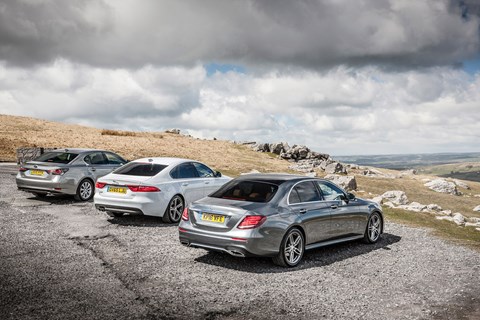
Key Tech: Mercedes E-class – piloted driving
While legislation prevents UK buyers from using the ‘indicate to change lane’ function available in Europe, the new E-class still takes a big step towards autonomous driving when you option the Drive Pilot ‘extended tolerance’ hands-free capability. You get 60sec between wheel touches on the motorway, 30sec on rural roads – up from 15sec with the basic lane keep assist system. That’s long enough to safely make a note, even if the Mercedes isn’t always the smoothest chauffeur.
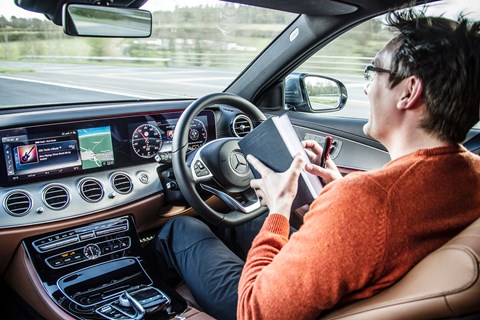
Key tech: Jaguar XF – aluminium über alles?
The switch from steel to aluminium for the vast majority of the second generation XF’s monocoque (closely related to that of the XE) has helped reduce the car’s weight by as much as 190kg. As a result the 177bhp 2.0-litre turbodiesel is 85kg lighter than the Mercedes and 135kg lighter than the Lexus. Yet the structure is also 28% stiffer than before. Both these factors help deliver a decisive handling advantage over the rivals here, making the XF most fun to drive.

Key Tech: Lexus GS300h – hybrid or turbodiesel?
Lexus has unapologetically ditched the diesel, and if you believe half of what science says about NOx and particulate emissions it’s hard not to respect the decision – even if the larger motivation is market driven; the USA and Japan still don’t really do diesel at all. As for everyday running costs, during our test the GS300h’s 35.1mpg proved efficient enough to out eco the thrash-me-harder Jag’s 31.8mpg, but still trailed behind Merc’s new 2.0-litre diesel and its 41.4mpg.
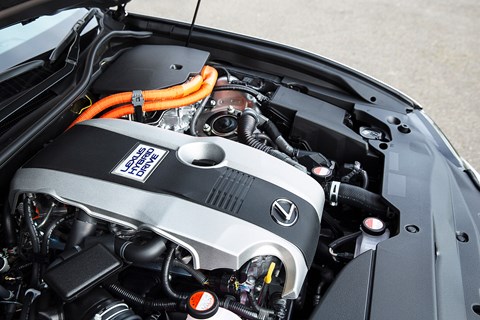
Mercedes-Benz E220d AMG Line specs
Price (as tested) £38,430 (£51,130)
Transmission Nine-speed automatic, RWD
Engine 1950cc turbodiesel 4-cyl
Suspension Four-link front, five-link rear (multistage air, as tested)
Made of Aluminium and steel
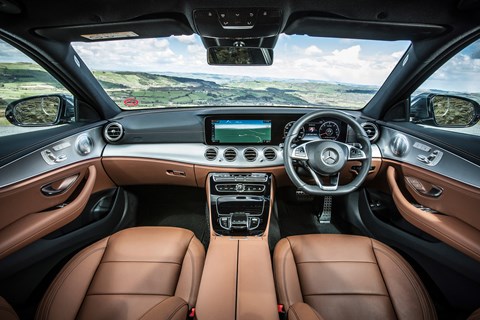
Jaguar XF 2.0d 180 R Sport specs
Price (as tested) £36,850 (£49,500)
Transmission Eight-speed automatic, RWD
Engine 1999cc turbodiesel 4-cyl
Suspension Double wishbone front; integral link rear
Made of Aluminium and steel
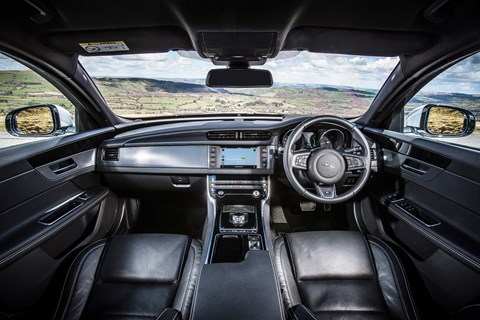
Lexus GS300h Executive Edition specs
Price (as tested) £33,495 (£34,105)
Transmission Electric CVT, RWD
Engine 2494cc 16v 4-cyl plus single e-motor
Suspension Double wishbone front, multi-link rear
Made of Steel
